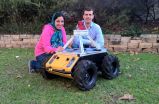Probing what happens to plutonium in a nuclear explosion
2015-06-10
(Press-News.org) For years, research on nuclear weapons has relied on old data, limited experiments and computer modeling. But this year, that pattern has changed. Scientists have run new experiments that simulate what happens to plutonium in a nuclear explosion, according to an article in Chemical & Engineering News (C&EN), the weekly newsmagazine of the American Chemical Society. The research will deepen scientists' understanding of the element -- and help them analyze a nuclear event should one occur.
In the article, Jyllian Kemsley, a senior editor at C&EN, notes that six years ago, the Department of Energy completed construction of its $3.5 billion National Ignition Facility at Lawrence Livermore National Laboratory in California. It has been widely recognized for its efforts to study nuclear fusion as a possible new energy source. But the facility, which boasts 192 high-power lasers, is also exploring nuclear weapons science.
In the first two experiments of this program, scientists sandwiched a thin wafer of plutonium -- radioactive but not weapons-grade -- with the diameter of a poppy seed between disks of aluminum and diamond. They shot 16 lasers at the top layer to compress the plutonium to help understand how the material responds to the high pressures and temperatures experienced in a nuclear detonation. Analyzing the debris that resulted could help scientists perform forensic analyses in the case of an actual detonation.
INFORMATION:
The American Chemical Society is a nonprofit organization chartered by the U.S. Congress. With more than 158,000 members, ACS is the world's largest scientific society and a global leader in providing access to chemistry-related research through its multiple databases, peer-reviewed journals and scientific conferences. Its main offices are in Washington, D.C., and Columbus, Ohio.
To automatically receive news releases from the American Chemical Society, contact newsroom@acs.org.
Follow us: Twitter Facebook END
ELSE PRESS RELEASES FROM THIS DATE:
2015-06-10
Using the intestinal hormone GLP-1 in obesity treatment prevents the loss of bone mass otherwise frequently associated with major weight loss. This is the finding of a new study from the University of Copenhagen, Hvidovre and Glostrup Hospital. According to the researchers behind the study, the results may have a significant bearing on future obesity treatment.
Rapid weight loss leads to a loss of bone mass and an increased risk of bone fractures. New research shows that treating obesity with the GLP-1 hormone helps prevent loss of bone mass in addition to having a number ...
2015-06-10
June 10, 2015--Low-income families bear the brunt of high-energy costs and poor thermal comfort from poorly maintained apartment buildings. To study how energy efficiency upgrades could help these households, researchers at Columbia University's Mailman School of Public Health surveyed residents in a low-income community in New York City. They found that while energy efficiency upgrades varied significantly by ownership status, low-income single-family homeowners reaped the greatest direct benefits. Results overall showed that respondents experienced improved thermal comfort, ...
2015-06-10
WASHINGTON - While a 1980 reform law enabled the modernization and stabilization of the U.S. freight railroad industry, federal regulation has not kept pace with the industry's transformation and should be replaced with a system better-suited for today's freight rail system, says a new congressionally mandated report from the National Research Council's Transportation Research Board. Current policies designed to protect rail shippers who lack transportation options from excessive rates are not working for shippers of most commodities, including grain. More appropriate, ...
2015-06-10
The way insects see and track their prey is being applied to a new robot under development at the University of Adelaide, in the hopes of improving robot visual systems.
The project - which crosses the boundaries of neuroscience, mechanical engineering and computer science - builds on years of research into insect vision at the University.
In a new paper published today in the Journal of The Royal Society Interface, researchers describe how the learnings from both insects and humans can be applied in a model virtual reality simulation, enabling an artificial intelligence ...
2015-06-10
CHICAGO (June 10, 2015): As health insurers place more emphasis on paying for quality outcomes rather than for specific services provided by doctors and hospitals, several quality improvement programs have been developed as a way to help health care providers identify problem areas and share best practices. While some studies have evaluated how well these quality improvement programs achieve their goals, not many have focused on the area of trauma care. But now a team of trauma surgeons at the University of Michigan in Ann Arbor have reported how data from a statewide ...
2015-06-10
Origami, the Japanese art of paper folding, can be used to create beautiful birds, frogs and other small sculptures. Now a Binghamton University engineer says the technique can be applied to building batteries, too.
Seokheun "Sean" Choi developed an inexpensive, bacteria-powered battery made from paper, he writes in the July edition of the journal Nano Energy.
The battery generates power from microbial respiration, delivering enough energy to run a paper-based biosensor with nothing more than a drop of bacteria-containing liquid. "Dirty water has a lot of organic matter," ...
2015-06-10
DARIEN, IL - A new study suggests that one night of partial sleep deprivation promotes biological aging in older adults.
Results show that one night of partial sleep deprivation activates gene expression patterns in peripheral blood mononuclear cells (PBMCs) consistent with increasing accumulation of damage that initiates cell cycle arrest and increases susceptibility to senescence. These findings causally link sleep deprivation to the etiology of biological aging, and further supports the hypothesis that sleep deprivation may be associated with elevated disease risk ...
2015-06-10
As it turns out, people who speak their minds loudly and often could be responsible for economic prosperity.
That's according to a new study by Michigan State University economist Siddharth Chandra, director of MSU's Asian Studies Center, and Nita Rudra, associate professor in the Department of Government at Georgetown University.
"Our study demonstrates that freedom to express our opinions is not just something we should enjoy," said Chandra, who's also a professor in MSU's James Madison College. "It could have very important consequences - sometimes preventing the ...
2015-06-10
DARIEN, IL - A new study suggests that pre-diagnostic short sleep duration and frequent snoring were associated with significantly poorer cancer-specific survival, particularly among women with breast cancer.
Results show that stratified by cancer site, short sleep duration and frequent snoring were associated with significantly poorer breast cancer-specific survival.
"Our results suggest that sleep duration is important for breast cancer survival, particularly in women who snore," said lead author Amanda Phipps, assistant professor of epidemiology at the University ...
2015-06-10
From AGU's blogs: New Tool Could Track Space Weather 24 Hours Before Reaching Earth
A new model, described in a June 9 paper in the journal Space Weather, might finally give scientists a tool to predict a coronal mass ejection's magnetic configuration from afar, which means forecasters could give utility grid and satellite operators a full 24-hour advance warning to protect their systems.
From AGU's journals: Satellite Measurements May Help Real-Time Water Management
With the demand for water stored in reservoirs rising in many areas, it is becoming increasingly ...
LAST 30 PRESS RELEASES:
[Press-News.org] Probing what happens to plutonium in a nuclear explosion

